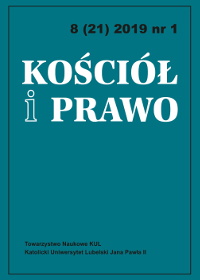The Impact of the 1925 Concordat between the Apostolic See and the Republic of Poland on the Eparchy of Stanislaviv
Abstract
After the collapse of the Central Powers, the Ukrainian and Polish authorities tried to restore their own states. These attempts were essentially hindered by the ethno-political situation in Galicia, especially after the decision of the Entente on 15 March 1923 to append East Galicia to Poland. The Ukrainian Greek-Catholic Church (UGCC) faced another opportunity and challenge – to cooperate with a new government under different circumstances. Such a geopolitical change led to a kind of legal nihilism concerning Church-State relations, which introduced selective justice. These legal relations should have been resolved by way of a ruling (concordat) between the Apostolic See and the Polish State. The chief preconditions for the drafting of a concordat by the Ukrainian Greek-Catholic Church were: legal uncertainty, financial and economic difficulties, and the sociopolitical issues in society. In this preparatory process, the Byzantine rite Church was led by Metropolitan Šeptytsky, who spoke on behalf of his bishops of Stanislaviv and Przemyśl and the faithful. It was important for the UGCC to clarify the questions of ecclesiastical property, elections of bishops, baptismal certificate, education, and ecclesiastical structures. The agreement, signed on February 10th, 1925, obliged all UGCC bishops to take an oath of allegiance, including Bishop Hryhorij Chomyšyn (1867-1945), to the Polish President and pledge their loyalty to the state.
References
Baran, Stepan. 1940. “Tserkovne pytannia w Polshchi.” https://zbruc.eu/node/353 74 [eingesehen am: 16.04.2019].
Baran, Stepan. 1947. Mytropolyt Andrei Sheptyts’kyi. Zhyttia i dijalnist. München: Vernyhora.
“Die Rolle der katholischen Kirche in der polnischen Geschichte seit 1795.” http:// www.puhli.de/uni/papers/kirche-in-polen/geschichte.html [eingesehen am: 17.04.2019].
Hentosh, Liliana. 2016a. “Rol’metropolyta Andreia Sheptyts’koho v ukladenni konkordatu mizh Apostolskym Prestolom i Polshcheju (1925).” Posen 10:115-28.
Hentosh, Liliana. 2016b. “Hreko-katolytskoji tserkvy u Polshchi do pidpysannja konkordatu 1925 r.” Eminak 1(3): 21-25.
Jehreshij, Oleh. 2003. Suspilno-politychna ta kulturalno-prosvitnycka dijalnist jepyskopa Hryhorija Chomyšyna (1904-1945 rr). Ivano-Frankivsk: Prykarpats’kyy natsional’nyy universytet imeni Vasylya Stefanyka.
Mroěz, Maciej. 2004. W kregu dyplomacji watykaněskiej. Rosja, Polska, Ukraina w dyplomacji Watykaněskiej w latach 1917-1926. Toruně: Wydawnictwo Adam Marszałek.
Perewesij, Vitaliy. 1998. Hreko-katolytska tserkvy v umovach ukrainsko-polskoi konfrontacii 20 roky XX st. Kiev: Natsional’na akademiya nauk Ukrayiny, Instytut politychnykh ta etnonatsional’nykh doslidzhen’.
Pylypiv, Ihor. 2013. “Pravovyj status hreko-katolytskoi tserkvy d druhij Rechi Pospolytij (1925-1939).” Efektyvnist derzhavnoho upravlinnia (Effektivität der staatlichen Verwaltung) 34:153-62.
Wolf, Hubert. 2010. Pope and Devil. The Vatican’s Archives and the Third Reich. Cambridge: The Belknap Press of Harvard University Press.
Copyright (c) 2019 Kościół i Prawo

This work is licensed under a Creative Commons Attribution-NonCommercial-NoDerivatives 4.0 International License.





